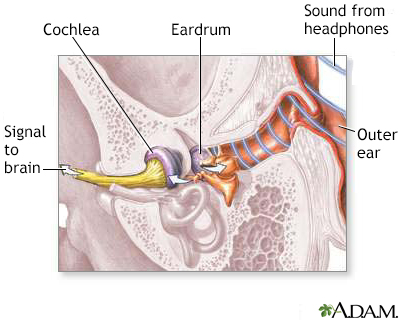Pregnancy SmartSiteTM
Injury - inner ear; Trauma - inner ear; Ear injury DefinitionAcoustic trauma is injury to the hearing mechanisms in the inner ear. It is due to very loud noise. CausesAcoustic trauma is a common cause of sensory hearing loss. Damage to the hearing mechanisms within the inner ear may be caused by:
SymptomsSymptoms include:
Exams and TestsThe health care provider will most often suspect acoustic trauma if hearing loss occurs after noise exposure. A physical exam will determine if the eardrum is damaged. Audiometry may determine how much hearing has been lost. TreatmentThe hearing loss may not be treatable. The goal of treatment is to protect the ear from further damage. Eardrum repair may be needed. A hearing aid may help you communicate. You can also learn coping skills, such as lip reading. In some cases, your provider may prescribe steroid medicine to help bring back some of the hearing. Outlook (Prognosis)Hearing loss may be permanent in the affected ear. Wearing ear protection when around sources of loud sounds may prevent the hearing loss from getting worse. Possible ComplicationsProgressive hearing loss is the main complication of acoustic trauma. Tinnitus (ear ringing) can also occur. When to Contact a Medical ProfessionalContact your provider if:
PreventionTake the following steps to help prevent hearing loss:
ReferencesArts HA, Adams ME. Sensorineural hearing loss in adults. In: Flint PW, Francis HW, Haughey BH, et al, eds. Cummings Otolaryngology: Head and Neck Surgery. 7th ed. Philadelphia, PA: Elsevier; 2021:chap 152. Crock C, de Alwis N. Ear, nose and throat emergencies. In: Cameron P, Little M, Mitra B, Deasy C, eds. Textbook of Adult Emergency Medicine. 5th ed. Philadelphia, PA: Elsevier; 2020:chap 18.1. Le Prell CG. Noise-induced hearing loss. In: Flint PW, Francis HW, Haughey BH, et al, eds. Cummings Otolaryngology: Head and Neck Surgery. 7th ed. Philadelphia, PA: Elsevier; 2021:chap 154. | |
| |
Review Date: 5/2/2024 Reviewed By: Josef Shargorodsky, MD, MPH, Johns Hopkins University School of Medicine, Baltimore, MD. Also reviewed by David C. Dugdale, MD, Medical Director, Brenda Conaway, Editorial Director, and the A.D.A.M. Editorial team. The information provided herein should not be used during any medical emergency or for the diagnosis or treatment of any medical condition. A licensed medical professional should be consulted for diagnosis and treatment of any and all medical conditions. Links to other sites are provided for information only -- they do not constitute endorsements of those other sites. No warranty of any kind, either expressed or implied, is made as to the accuracy, reliability, timeliness, or correctness of any translations made by a third-party service of the information provided herein into any other language. © 1997- A.D.A.M., a business unit of Ebix, Inc. Any duplication or distribution of the information contained herein is strictly prohibited. | |

 Sound wave transmi...
Sound wave transmi...
